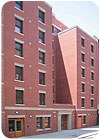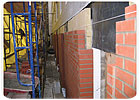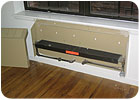
The outside of the apartment doesn’t look any different from other
buildings.
A lot of developers, designers and builders like the idea of energy-efficient buildings, but not the idea of the additional costs and complications. With those assumptions, it’s easy to conclude that saving energy has to cost extra.
Nothing could be further from the truth.
For the past 10 years, I’ve been a part of the design team ofChris Benedict, a New York City architect, who designs multifamily buildings that disprove these ideas by being extremely energy-efficient without costing extra to build.
Two of her apartment house designs recently completed in Manhattan don’t look very different from other new apartment houses being built in the area. What is different is the amount of energy the buildings use.
The multifamily building at 299 E. Third St. is a six-story, 38-unit building. Yet the boiler that supplies both heat and hot water is so small it has a 10-inch diameter chimney. The Weil-McLain 880 boiler has an input of 1.08 million Btus and an I=B=R gross output of 872,000 Btus. The building at 228 E. Third St. is a seven-story, 22-unit building. And its boiler has only an 8-inch chimney - smaller than what a lot of single-family houses have. The Weil-McLain 580 boiler has a firing rate of 639,000 Btus and an I=B=R gross output of 515,000 Btus.
Carefully calculating a building’s energy load and measuring its “airtightness” gives us enough confidence to specify surprisingly small mechanical systems. By paying attention to these things, we have designed buildings that use less than 4 Btus per square foot per heating degree day for heat, and less than 16,000 Btus per square foot per year for domestic hot water. We think this is less than any other apartment building in the United States, and challenge anyone to show us lower fuel bills.
This translates to about 15 percent of the energy an average New York City apartment building uses for heat and hot water. In other words, about 85 percent of the heating and hot water energy of an average building has been eliminated at no extra construction cost.

The energy-efficient design of the building allows for smaller boilers
to provide heat and hot water.
Energy Load
The first step in controlling a building’s energy load should always be to carefully calculate how much heating and cooling energy every room would use. Nevertheless, this calculation is often skipped, or replaced with a rough estimate under pressure from the tight construction schedules and budgets that prevail in the industry today.What the math would reveal is that about half of the heating load and much of the cooling load is the result of air leaking through the average building. Only half is conducted through materials the architect specifies in the wall, while the rest sneaks through cracks and small holes not shown on the plans. Reducing this unintended air leakage has huge potential for improving people’s health and comfort, while also saving energy.
But these are not the only benefits. Reducing air leakage makes buildings less vulnerable to the spread of smoke and fire, and can make them soundproof enough to minimize noise complaints.
Despite the fact that fire codes indirectly ask for “smoke-tight” and, therefore, airtight demising walls, it is a construction detail that is frequently ignored. That makes it fair to say that it costs extra. However, because airtightening reduces heating and cooling loads, the extra cost can reduce the cost of other parts of construction by allowing the substitution of smaller heating, cooling and ventilation systems.
Another important part of energy efficiency is to have working thermostats in every room. They can respond to the heat provided by “free” solar energy and even cooking heat that would normally be ignored. Not only do they improve comfort and save energy, but the thermostats can pay for themselves before the designs are built.
Heating system designs are based on the idea that the system has to be large enough to adequately heat a building on the coldest night of the year. In a normal multifamily building, without individual thermostats, this means adequately heating the windward side while overheating the leeward side of the building.
In multifamily buildings with thermostats in each room, the leeward side of the building won’t overheat. If a design team is careful, this can allow a reduction in the size of the boiler and most other heating system components, thus reducing materials and construction costs by more than the cost of the thermostats.
All design teams should work together on the math for every project, because by working closely as a team they can discover small changes that make a big difference in energy use. When teams separate architecture and mechanical design tasks, these opportunities tend to be lost.

Behind the exterior brick is a layer of mineral wool insulation that
stretches interrupted by studs, pipes, wires, etc.
Ventilation
Over-sized mechanical equipment isn’t the only problem to address. People also deserve better breathing air that has infiltrated through musty/dusty walls. Mold also can be a factor depending on temperature and humidity.As a result, we stick to the principle of “Build Airtight and Ventilate Right.”
The first step in good ventilation system design is to avoid the normal practice of connecting many apartments with one ventilation system.
A typical ventilation system in a New York City apartment building connects bathrooms and kitchens to a vertical duct that leads to a fan on the roof. Plans usually depict arrows and labels that show a reasonable and healthy airflow from each apartment. However, measurements of airflow in real-life systems show a very different picture. The fan pulls a lot of air from the upper-floor apartments, less from apartments in the middle of the building, and maybe none from lower-floor apartments.
Normal systems not only do a poor job of ventilating buildings, but they can conduct smoke and noise and smells from one apartment to another, especially when the fan is not working. These problems can all be solved with a unique ventilation system Benedict invented.
228 and 299 E. Third Street are built with standard precast concrete planks. The planks are cast in a factory, trucked to the construction site, and “dropped” onto the load-bearing walls with a crane. They are about 10-meters long, 3-meters wide, and 200-milimeters thick, with 125-milimeter diameter holes running down the middle the long way, to increase the strength-to-weight ratio. These holes are used as part of the ventilation system.
Standard Panasonic inline fans, which have a well-deserved reputation for being very quiet, are installed in a ceiling above a closet. Each fan pulls air from the bathrooms and kitchens through standard round metal ducts. The fans push the air up into one of the holes in the plank, through the length of the plank to the edge of the building, and then out an exhaust grill on the front or back wall.
Air is supplied through “trickle vents” installed in each bedroom window. They permit a limited amount of air to enter, while keeping out rain and insects. The air passes through the bedrooms, then through the common rooms, then out through the exhaust vents in the bathrooms and kitchens, ventilating every room in the apartment.
This design uses very little ductwork, saving the floor space vertical ductwork would normally occupy. The short ducts don’t connect apartments to each other, so they don’t need the same level of fire protection as ducts that cross fireproof separations between apartments.
One trade can install the system, instead of coordinating roofers, electricians, carpenters and sheet metal workers on the roof. It is so inexpensive that even the ventilation subcontractors admit it is cheaper than a normal system.
Best of all, it actually works. It moves the correct amount of air 24 hours a day, regardless of wind, temperature, or the opening and closing of windows and doors throughout the building.
For cooling, designers have many systems to choose from. We first rejected any system involving ductwork. Even if the owner wanted to sacrifice space for ducts, too many unhealthy things can grow in ducts that are full of damp air. Ducted systems also require a lot of fan energy to move all the air around, which causes another problem: Different air pressures in different rooms increases air leakage through the walls, which brings in heat and humidity.

A thermostat is attached on the lower right-hand corner of the uncovered
convector.
This left us with a choice between sleeve units and window units. Sleeve units cost three or four times as much as window units, are not available small enough for one room in an efficient building, leak air all year long, and are inherently less efficient because the sleeve blocks cooling air from the sides of the unit.
This made window units the obvious choice for us. They use little energy moving air, are automatically zoned room-by-room, reject condensate outdoors, and the energy is billed to the user. We worked with the owner to encourage proper sizing (small!) and installation. For future buildings, we plan to incorporate fixed but removable panels in windows to accommodate better installations.
This combination of airtightness, working ventilation systems and room-by-room temperature control improves the performance of almost any building.
It does take extra effort to design buildings that work so well. But it is worth it in the short term, because they can be built and occupied quickly with little worry about the many problems that often plague new buildings. In the long run, buildings that perform better improve the health and comfort of the occupants, while operating at a lower cost. Not only a lower cost to the owner, but at a lower cost to the environment, which is perhaps the highest cost of all.
This article was originally published in Lessons Learned. The Costs & Benefits of High Performance Buildings. Published by Earth Day New York, 2006. www.earthdayny.org.
